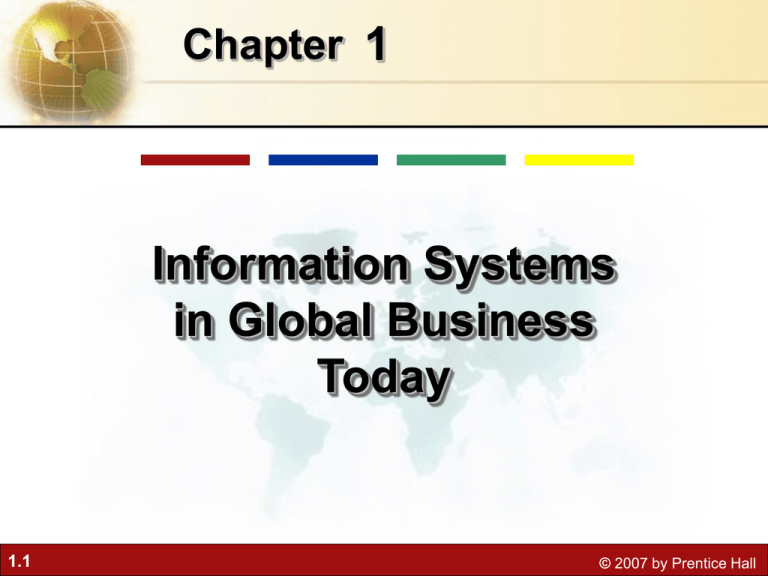What is an information system?
advertisement

Chapter 1 Information Systems in Global Business Today 1.1 © 2007 by Prentice Hall Management Information Systems Chapter 1 Information Systems in Global Business Today LEARNING OBJECTIVES • Explain why information systems are so essential in business today. • Define an information system from both a technical and a business perspective. • Identify and describe the three dimensions of information systems. 1.2 © 2007 by Prentice Hall Management Information Systems Chapter 1 Information Systems in Global Business Today LEARNING OBJECTIVES (Continued) • Assess the complementary assets required for information technology to provide value to a business. • Identify and describe contemporary approaches to the study of information systems and distinguish between computer literacy and information systems literacy. 1.3 © 2007 by Prentice Hall Management Information Systems Chapter 1 Information Systems in Global Business Today Smart Systems and Smart Ways of Working Help Toyota Become Number One • Problem: Tough competition and demanding customers. • Solutions: Redesigned order and production processes reduce costs, increase revenue, and improve customer service. • Oracle E-Business Suite makes it possible to build cars to order and forecast demand and production requirements more accurately. • Demonstrates IT’s role in analyzing market trends and monitoring quality, efficiency, and costs. • Illustrates the emerging digital firm landscape where businesses can use tools to analyze critical data. 1.4 © 2007 by Prentice Hall Management Information Systems Chapter 1 Information Systems in Global Business Today The Role of Information Systems in Business Today • How information systems are transforming business • Globalization opportunities • The emerging digital firm • Strategic business objectives of information systems • Operational excellence • New products, services, and business models • Customer and supplier intimacy • Improved decision making • Competitive advantage • Survival 1.5 © 2007 by Prentice Hall Management Information Systems Chapter 1 Information Systems in Global Business Today The Role of Information Systems in Business Today Information Technology Capital Investment Information technology investment, defined as hardware, software, and communications equipment, grew from 34% to 50% between 1980 and 2004. Source: Based on data in U.S. Department of Commerce, Bureau of Economic Analysis, National Income and Product Accounts, 2006. Figure 1-1 1.6 © 2007 by Prentice Hall Management Information Systems Chapter 1 Information Systems in Global Business Today The Role of Information Systems in Business Today Virtual Management at Accenture • Read the Interactive Session: Organizations, and then discuss the following questions: • What are the advantages of working in a virtual environment like the one created by Accenture? What are the disadvantages? • Would you like to work at a company like Accenture? Why or why not? Explain your answer. • What kinds of companies could benefit from being run virtually like Accenture? Could all companies be run virtually like Accenture? 1.7 © 2007 by Prentice Hall Management Information Systems Chapter 1 Information Systems in Global Business Today The Role of Information Systems in Business Today The Interdependence Between Organizations and Information Technology There is a growing interdependence between a firm’s information systems and its business capabilities. Changes in strategy, rules, and business processes increasingly require changes in hardware, software, databases, and telecommunications. Often, what the organization would like to do depends on what its systems will permit it to do. Figure 1-2 1.8 © 2007 by Prentice Hall Management Information Systems Chapter 1 Information Systems in Global Business Today Perspectives on Information Systems • What is an information system? • Dimensions of information systems – Organizations – Management – Technology • It isn’t just a technology: A Business perspective on information systems • Complementary assets: Organizational capital and the right business model 1.9 © 2007 by Prentice Hall Management Information Systems Chapter 1 Information Systems in Global Business Today Perspectives on Information Systems Data and Information Raw data from a supermarket checkout counter can be processed and organized to produce meaningful information, such as the total unit sales of dish detergent or the total sales revenue from dish detergent for a specific store or sales territory. Figure 1-3 1.10 © 2007 by Prentice Hall Management Information Systems Chapter 1 Information Systems in Global Business Today Perspectives on Information Systems Information Systems Are More Than Computers Using information systems effectively requires an understanding of the organization, management, and information technology shaping the systems. An information system creates value for the firm as an organizational and management solution to challenges posed by the environment. Figure 1-5 1.11 © 2007 by Prentice Hall Management Information Systems Chapter 1 Information Systems in Global Business Today Perspectives on Information Systems UPS Competes Globally with Information Technology • Read the Interactive Session: Technology, and then discuss the following questions: • What are the inputs, processing, and outputs of UPS’s package tracking system? • What technologies are used by UPS? How are these technologies related to UPS’s business strategy? • What problems do UPS’s information systems solve? What would happen if these systems were not available? 1.12 © 2007 by Prentice Hall Management Information Systems Chapter 1 Information Systems in Global Business Today Contemporary Approaches to Information Systems • Technical approach • Behavioral approach • Approach of this text: Sociotechnical systems 1.13 © 2007 by Prentice Hall





